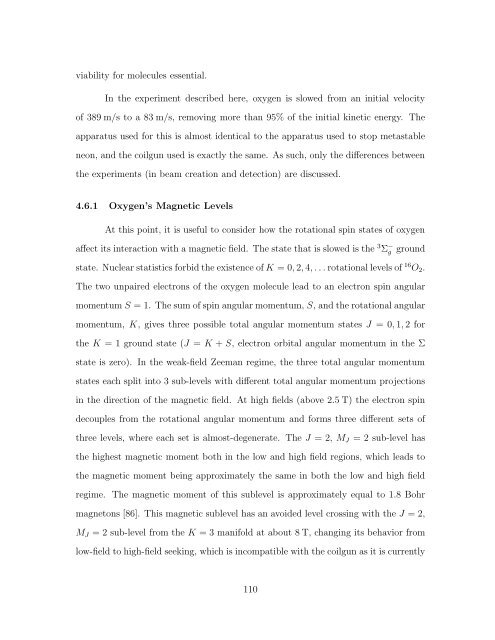Experiments with Supersonic Beams as a Source of Cold Atoms
Experiments with Supersonic Beams as a Source of Cold Atoms
Experiments with Supersonic Beams as a Source of Cold Atoms
You also want an ePaper? Increase the reach of your titles
YUMPU automatically turns print PDFs into web optimized ePapers that Google loves.
viability for molecules essential.<br />
In the experiment described here, oxygen is slowed from an initial velocity<br />
<strong>of</strong> 389 m/s to a 83 m/s, removing more than 95% <strong>of</strong> the initial kinetic energy. The<br />
apparatus used for this is almost identical to the apparatus used to stop met<strong>as</strong>table<br />
neon, and the coilgun used is exactly the same. As such, only the differences between<br />
the experiments (in beam creation and detection) are discussed.<br />
4.6.1 Oxygen’s Magnetic Levels<br />
At this point, it is useful to consider how the rotational spin states <strong>of</strong> oxygen<br />
affect its interaction <strong>with</strong> a magnetic field. The state that is slowed is the 3 Σ − g ground<br />
state. Nuclear statistics forbid the existence <strong>of</strong> K =0, 2, 4,...rotational levels <strong>of</strong> 16 O2.<br />
The two unpaired electrons <strong>of</strong> the oxygen molecule lead to an electron spin angular<br />
momentum S = 1. The sum <strong>of</strong> spin angular momentum, S, and the rotational angular<br />
momentum, K, gives three possible total angular momentum states J =0, 1, 2for<br />
the K = 1 ground state (J = K + S, electron orbital angular momentum in the Σ<br />
state is zero). In the weak-field Zeeman regime, the three total angular momentum<br />
states each split into 3 sub-levels <strong>with</strong> different total angular momentum projections<br />
in the direction <strong>of</strong> the magnetic field. At high fields (above 2.5 T) the electron spin<br />
decouples from the rotational angular momentum and forms three different sets <strong>of</strong><br />
three levels, where each set is almost-degenerate. The J =2,MJ = 2 sub-level h<strong>as</strong><br />
the highest magnetic moment both in the low and high field regions, which leads to<br />
the magnetic moment being approximately the same in both the low and high field<br />
regime. The magnetic moment <strong>of</strong> this sublevel is approximately equal to 1.8 Bohr<br />
magnetons [86]. This magnetic sublevel h<strong>as</strong> an avoided level crossing <strong>with</strong> the J =2,<br />
MJ = 2 sub-level from the K = 3 manifold at about 8 T, changing its behavior from<br />
low-field to high-field seeking, which is incompatible <strong>with</strong> the coilgun <strong>as</strong> it is currently<br />
110
















